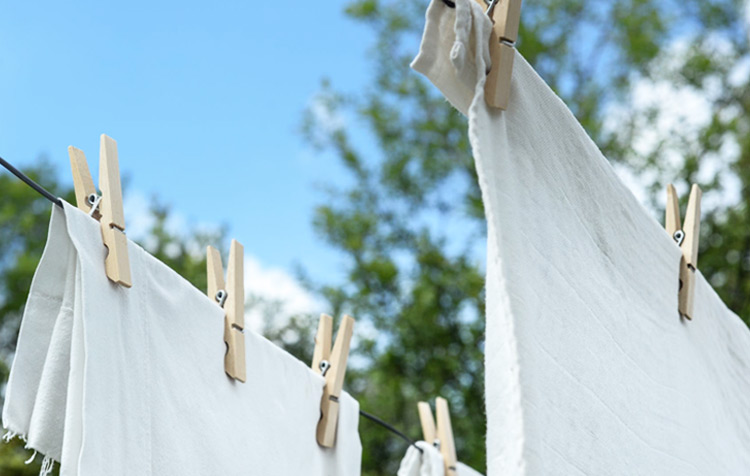Wondering how to do your laundry sustainably? Great! Then you've come to the right place. Whether it's the washing machine, the choice of detergent or the way you dry your laundry - there are plenty of opportunities everywhere for a much more environmentally friendly washday.
In this article, I would therefore like to introduce you to 11 valuable tips for sustainable laundry washing, which have literally "washed"! In addition, you will learn in advance why it is actually so important to pay attention. Let's go!
Here already a short Overview in advance:
- Make detergent yourself
- Use ecological washing powder
- Air dry
- Use wooden clothespins
- Set on durable laundry basket
- Use energy efficient washing machine
- Wash only as warm as necessary
- Washing machine fully loaded
- Do without fabric softener
- Washing machine regular maintenance
- Use laundry net and filter microplastics
Why you should wash your laundry sustainably
Before we get into what to do, let's be aware of why to do it. Here's a little insight into the problems we can solve by doing laundry in an environmentally friendly way:
- Consumption: In the past, there was traditional washing powder from cardboard packaging. Today, this manageable selection is supplemented by chemical gel capsules and compact and liquid detergents in all colors and shapes. At the same time, you can save money just by being minimalist and sustainable thinking really save a lot of money and at the same time protect the environment.
- Environment: According to NABU, 600,000 tons of detergent and 250,000 tons of fabric softener end up in wastewater every year - and the trend is still rising. The ingredients (mainly surfactants, enzymes and fragrances) can migrate via wastewater treatment plants into rivers, lakes and oceans.₁ Added to this is the large amount of plastic packaging that ends up in the trash immediately after consumption. The high consumption of resources by and for washing machines, tumble dryers or irons must also not be forgotten.
11 valuable tips for sustainable laundry washing

You now basically know what it's all about - and why your help is needed. We can all be either part of the problem or part of the solution. Use the following tips to make a difference yourself and wash your clothes more sustainably in the future.
1. make detergent itself
Why spend so much money on chemical detergents, when you can get it for example from Ivy, Chestnuts or Curd soap can also simply make it yourself? That way, you have control over which ingredients go into it. And you can also save a lot of packaging waste.
In the article Make detergent yourselfyou'll find out exactly what you need to watch out for.
2. ecological washing powder in sufficient quantities.
Maybe you don't feel like making your own detergent. One thing is certain: we don't need hundreds of different detergents from the drugstore, but a maximum of three: Heavy duty detergent, Color detergent and for wool clothing also Wool detergent.
Detergent as a powder is definitely more environmentally friendly than the liquid counterpart, as they are Less surfactants and no preservatives contained. The washing powder is also often available in the cardboard packaging without plastic.
Make sure that you only use the absolutely necessary amount so that you don't waste too much. Also, buy high concentrates that are free of unnecessary fillers and make it easier for you to wash your clothes sustainably.
3. drying in the air
The ecological and financial advantages of a clothes horse, a space-saving extendable clothesline or a rotary clothes dryer - i.e. air drying - over electric clothes dryers are explained relatively quickly. You do not consume electricitywhich may also come from non-renewable sources. And you save a lot of moneyYou'll have the sun and the air do the work for you. All you need are a few clothespins and a line to hang shirts, pants or the bed linen in the air to be dried. For pillows, comforters and sheets alone, a single drying process usually has to be started with the machine. An energy expenditure that can definitely be avoided. Air drying is a simple idea that I would add to the sustainable lifehacks of our grandparents count.
Make sure you don't hang too much laundry so your line lasts a long time and your clothes dry quickly. A good place to go for manual Laundry dryer for the balcony offers you the hardware store. That's where I got my sisal clothesline, as well as my wooden clothespins and my stand-up dryer. And if you have to hang your laundry in your apartment, air it regularly to avoid mold.
Tip: You should shake out your clothes properly before drying and smooth them out if possible, so that you can save yourself ironing and thus a lot of Save energy can!
4. wooden clothespins

This tip for sustainable laundry is explained relatively quickly. Do without plastic clothespins and simply replace them with more natural ones Wood clothespins. In my opinion they are Much more durable.
If you like, you can get them get directly here.*
5. durable laundry basket
Not only the clothespins, but also the laundry basket can be produced in a fair and environmentally friendly way and made of sustainable material. For example, get a laundry basket made of organic cotton and bamboo wood as a durable Alternative to cheap plastic basket.
6. energy efficient washing machine
You don't necessarily have to wash your clothes with a washboard like grandma and grandpa did. Modern washing machines use much less water than they did in the 1990s, for example.₂ So when you buy one, make sure that it uses as little water as possible. water-saving and energy efficient works. It is definitely worth investing a bit more money in durable quality goods in the long run. So, the energy efficiency class should be at least an A+++.
Can you think of any other tips for sustainable laundry? Then always give it to me in the comments!
7. wash only as warm as necessary
Washing machines consume a lot of energy, especially at high temperatures. That is why the temperature selection of the washing cycle hides a great potential for environmental protection when washing laundry. Why? By normally soiled laundry simply with 30°C instead of 60°C you save around 67 percent of the electricity consumption₃ and ultimately see no difference in cleanliness. Because you can't get cleaner than clean.
8. washing machine fully loaded
When choosing your washing machine, also remember that the capacity should be as close as possible to your household, so that it is always well enough filled. Because The promised energy efficiency only comes into effect when the washing machine is full. For up to three people, for example, a capacity of about four kilograms is recommended. For five people or more, a washing machine with space for up to six kilograms of laundry is again more environmentally friendly.
Tip: So gather your laundry whenever possible and then wash it when a sufficient amount has been accumulated.
9. do without fabric softener
I used to use really a lot of fabric softener, because I thought it was absolutely necessary. But today I know that they have no cleaning function at all, but are only responsible for softness and a fresh scent. For that, they are full of chemicals that can get into our environment. Drying also becomes more difficult because the fabric softeners are still on the laundry.
10. washing machine regular maintenance
A washing machine is expensive - and extremely resource-intensive to manufacture. So it's worth it both for your wallet and for the environment if you clean it regularly and thereby Humidity, Detergent residues and Lingerie shorts no chance of attack.
In this regard, it is recommended, for example, that you use the Lint filter and the Door seal regularly clean the Washing machine and its compartments left open after washing and occasionally wash at a higher temperature. The latter will loosen stubborn grease and dirt residues in particular.
11. use laundry net and filter out microplastic
One last tip from me is to use a wash bag to keep plastics from your clothes from going down the drain. A significant portion of our fashion today contains small plastic fibers. This so-called Microplastics dissolves during washing and is difficult to filter out by wastewater treatment plants. And so it often ends up as Microplastics in the sea - one of our most inconspicuous, but biggest environmental problems.
A laundry net can catch a lot of these fibers. All you have to do is put your dirty clothes in it before the wash. After the wash cycle, you can simply remove the fibers.
Washing laundry sustainably - No problem, right?
See your evolution towards a more sustainable lifestyle as a step-by-step process. I hope I've been able to take you another step further with these tips for sustainable laundry. Use them to make a difference in your household yourself and to show others how easy it is to do.
Do you have any questions or suggestions? Then just write me a comment.
Stay sustainable,

PS: You want to learn more about sustainable living? Then take a look at my book "Sustainable living for beginners" inside.
References:
₁ NABU - Naturschutzbund Deutschland e.V.: Ecological Wash Day, available at https://t1p.de/gdft. [16.09.2020].
₂ Essex, J.; HeimHelden.de.: The water consumption of a washing machine. https://t1p.de/011o. [09.08.2020].
₃ M. DuMont Schauberg Expedition of Kölnische Zeitung GmbH & Co. KG: Experts explain - 60-degree washes are unnecessary and expensive (as of 07.09.2018). https://t1p.de/navq. [09.08.2020].







I'm in the middle of moving into my new apartment and have now noticed that my washing machine no longer works properly. Since I wanted to be a bit more sustainable anyway, I'm of the opinion that the old machine was no longer suitable anyway. It's good to know that for sustainable washing you really should use a modern washing machine, which at best has the energy efficiency class A+++. I also did not even know that only with a full washing machine the specified energy efficiency exists.
Comments are closed.